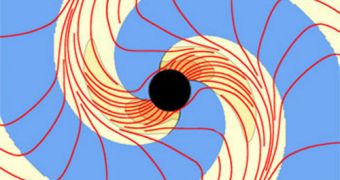Experts at the Cornell University conducted a new series of supercomputer simulations on the behavior of the black holes, and were able to observe for the first time how spacetime gets deformed when two such objects collide and merge with each other.
This usually happens when two galaxies containing dark behemoths at their cores collide with each other. Their gas mingles, and eventually their black holes will too. The other possibility is for one of the objects to be cast out of the newly formed galaxy.
The new simulations showed that, when mergers do occur, spacetime goes through what physicists call a “stormy behavior,” which means it gets distorted and deformed to a great extent. These new discoveries will be of tremendous use for astronomers.
They could enable experts to figure out the sources of various types of signals they encounter in space, and reverse-engineer what happened so that the signals were produced in the first place. This could lead to a better understanding of numerous cosmic phenomena.
At the same time, these results provide experts with a new view on black holes, gravity and cosmology. Explains California Institute of Technology (Caltech) theoretical physicist Kip Thorne.
“It's as though we had only seen the surface of the ocean on a calm day. We'd never seen the ocean in a storm, we'd never seen a breaking wave, we'd never seen water spouts […] We have never before understood how warped space and time behave in a storm,” the expert explains.
In past studies, experts were able to determine the forces governing the actions of a black hole when it was the sole occupant of a galactic core. But computer simulations were never carried out on what happened during an actual merger.
According to Cornell University postdoctoral astronomy researcher and study author Robert Owen, scientists are now working on three other studies, meant to explore the physicist and dynamics of various types of black hole mergers in more detail.
Thorne says that the new computer models could be used to make more sense of the data sent back by the Laser Interferometer Gravitational-Wave Observatory (LIGO) instrument. Its main role is to look for gravitational waves, relic distortions in spacetime left behind by the Big Bang.
Identifying them is tremendously complex, and determining where they came from and how they formed is even more so, experts say. This is whey they can use every piece of data they can get.
“We want to be able to look at the shapes of the waves and be able to go back and say what was happening to produce the waves,” Thorne explains, quoted by Space.

 14 DAY TRIAL //
14 DAY TRIAL //